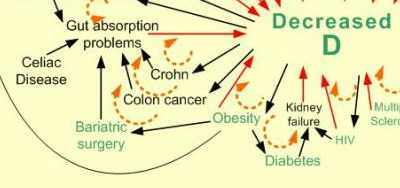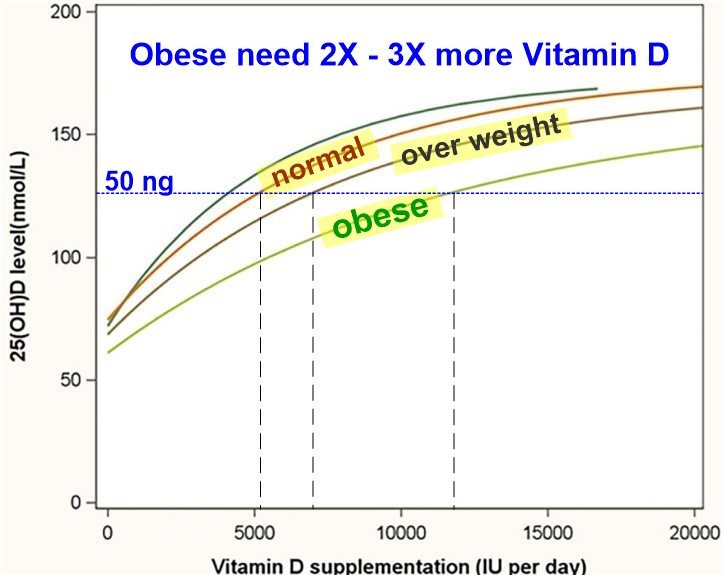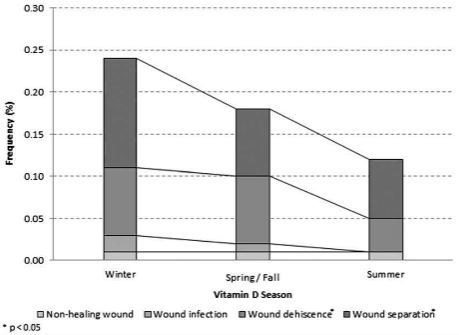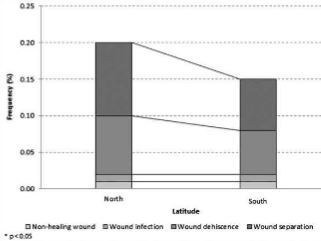Bariatric Surgery problems associated with season, latitude (low Vitamin D)
Proxy measures of vitamin D status - season and latitude - correlate with adverse outcomes after bariatric surgery in the Nationwide Inpatient Sample, 2001-2010: a retrospective cohort study.
Obes Sci Pract. 2015 Dec;1(2):88-96. Epub 2015 Dec 14.
Peterson LA1, Canner JK2, Cheskin LJ3, Prokopowicz GP4, Schweitzer MA5, Magnuson TH5, Steele KE5.
1The Johns Hopkins Center for Bariatric SurgeryBaltimoreUSA; The Johns Hopkins Bloomberg School of Public HealthBaltimoreUSA.
2The Johns Hopkins Center for Surgical Trials and Outcomes Research Baltimore USA.
3The Johns Hopkins Bloomberg School of Public HealthBaltimoreUSA; The Johns Hopkins Weight Management CenterBaltimoreUSA; The Global Obesity Prevention Center at Johns HopkinsBaltimoreUSA.
4The Johns Hopkins Outpatient Center Baltimore USA.
5The Johns Hopkins Center for Bariatric Surgery Baltimore USA.
 Latitude
* Vitamin D varies with latitude - map of Chile
1. Overview Gut and vitamin D contains the following summary
{include}
Overview Obesity and Vitamin D contains the following summary
{include}
Obese need 2X to 3X more vitamin D - Nov 2014 has the following
Latitude
* Vitamin D varies with latitude - map of Chile
1. Overview Gut and vitamin D contains the following summary
{include}
Overview Obesity and Vitamin D contains the following summary
{include}
Obese need 2X to 3X more vitamin D - Nov 2014 has the following
 ---
1. See also web
Bariatric surgery and vitamin D: key messages for surgeons and clinicians before and after bariatric surgery - June 2016
Publisher wants ~0163~85 for the PDF
---
1. See also web
Bariatric surgery and vitamin D: key messages for surgeons and clinicians before and after bariatric surgery - June 2016
Publisher wants ~0163~85 for the PDF
📄 Download the PDF from VitaminDWiki
| ** | |||
|---|---|---|---|
| North | South | ||
| Length of stay >3d | 43% | 32% | ** |
Wounds vs season

Wounds vs latitude

OBJECTIVE:
To investigate the association between adverse surgical outcomes following bariatric surgery and proxy measures of vitamin D (VitD) status (season and latitude) in the Nationwide Inpatient Sample (NIS).
BACKGROUND:
Obesity is an independent risk factor for VitD deficiency (25(OH)D < 20 ng ml-1). VitD deficiency compounds the chronic inflammation of obesity, increasing the risk of adverse outcomes following bariatric surgery. Epidemiology has long used season and latitude as proxies for group VitD, as VitD status is largely determined by sun exposure, which is greatest during summer and at the Equator.
METHODS:
We assessed proxy measures of group VitD status. We compared surgeries in VitD Summer (July to September), Winter (January to March), and Fall/Spring (October to December and April to June) and in the North (=37°N) vs. the South (<37°N).
RESULTS:
We identified 932,091 bariatric surgeries; 81.2% were women and 74.4% were white. Sex was unequally distributed by season (p = 0.005). Median age was 43.0 years (all groups). Most surgeries occurred in the North (64.8%). Adverse outcome rates ranged from 0.01% (wound infections) to 39.4% [prolonged length of stay {LOS}]. Season was inversely associated with wound infection (p = 0.018) and dehiscence (p = 0.001). Extended LOS was inversely correlated with season (p < 0.001). These relationships held after adjustment. Prolonged LOS (p < 0.001) and any complication (p = 0.108) were more common in the North.
CONCLUSIONS:
We have demonstrated a graded relationship between seasonality and adverse outcomes following bariatric surgery. The association was strongest for dehiscence and prolonged LOS. These relationships held when using latitude. A prospective study measuring pre-operative 25(OH)D concentration would strengthen the case for causality in adverse surgical outcomes.
PMID: 27774252 DOI: 10.1002/osp4.15
